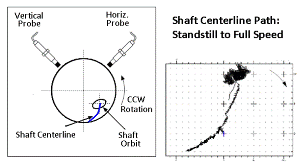OUR LOCATIONS
We can provide our services to power plants worldwide
Bradenton, Florida
941 - 527 - 6196
941 - 755 - 5229 (FAX)
Milwaukee, Wisconsin
414 - 698 - 5644
|

WE VERIFY THAT YOUR STARTUP
IS PROBLEM FREE
During startup, Z – R Consulting provides monitoring of many key machine diagnostics to verify that everything is running as it should be, and provides on the spot guidance and analysis should the need arise. We also analyze the startup data to ensure that there are no hidden problems that might show up later, as well as physically inspect the machine. This startup monitoring process verifies the quality of shop repairs.
Before a post-outage restart, we set up our data acquisition units on site, and coordinate with plant operators to gather all the needed data for a clear picture of the machine’s condition. In addition to standard vibration data, we also collect and analyze DC shaft centerline data that most others ignore. We track the shaft position for all bearings:

- At standstill
- On lift oil
- On turning gear
- Up to full speed no load (FSNL)
- Through full load to steady state
This data provides essential verification of the quality of alignment, and can also point to the root cause of bearing problems, such as heavy wear or instability issues. We examine startup data with our proprietary software to dynamically analyze and identify any misaligned or mispositioned bearing(s), and track the overall rotor train alignment through its full speed and load range.
We also measure all shaft vibration amplitudes and bearing forces:
- On turning gear
- During transient operation
- At steady state at full speed, with no load
- At full speed, through all load cycles, up to full load
Before load, problems can be isolated to mechanical causes, such as misalignment or unbalance. After loading and synchronizing to grid, we track vibration trends during the load cycle, and analyze the data for any potential Megawatt (torque) dependent or MVAR (heat) dependent issues.
Overall, if the shop repairs were done properly, and the rotor aligned correctly, there should be no real need for field balancing. Sometimes, we can perform field balancing for minor corrections (trim balancing) to bring particular vibration amplitudes below required contract limits.
However, field balancing is not true balancing, and is only useful to help meet contractual criteria. It is only effective for “point-balancing”, either at a specific location or a specific speed, and does not actually balance the rotor. Field balancing is at best a compromise that might lower a specific shaft amplitude reading, but typically at the expense of higher bearing forces and potential bearing damage.
The time to resolve any potential vibration problems is in the shop, not after reinstallation. If the rotor is properly handled by our specifications during the outage, and balanced using our proprietary balancing method, it will come out ready to run, and will not need further field balancing.
|